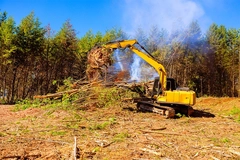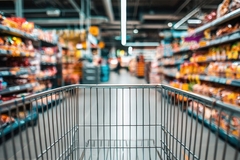
- Industry news
Industry news
- Category news
Category news
- Reports
- Key trends
- Multimedia
- Journal
- Events
- Suppliers
- Home
- Industry news
Industry news
- Category news
Category news
- Reports
- Key trends
- Multimedia
- Events
- Suppliers
Food production feeling the heat as climate crisis and drought hampers yields

19 Sep 2022 --- On top of supply chain issues, sky-high energy prices, the Ukraine war and commodity price speculation, industry is dealing with one of the hottest and driest years on record, which has burned out farmers and decreased agricultural yields across countries. FoodIngredientsFirst looks into how the climate continues to impact future foods.
The Northern Hemisphere drought has been so severe that Europe, for example, only received 20% of its usual rainfall, according to a report of the Joint Research Centre in collaboration with the European Commission’s scientific advisory body.
Southern Spain might lose most (up to 80%) of its Hojiblanca and Manzanilla olive oil varieties if global temperatures exceed the pre-industrial average by 2° C before 2050, according to a study by COAG, a Spanish union of farmers.

Spain is predicted to also lose “more than 10% of the most fertile soil for quality wine” and 8% of its wheat production.
Furthermore, a report from the National Observatory for Agriculture of Tunisia predicts that Spain’s olive yields will further decrease by 30% in production by the end of the Century, with the North African country already suffering a 7% drop in production – compared to the five-year average – due to the extreme climate.
Climate change’s impact on the food industry is supercharging inflation numbers in many countries, with consumers paying record amounts for food even though general inflation numbers are going down in most nations. Cost explosions in 2023 might be on the horizon.
 Sriracha production has been halted at Huy Fong’s California plant for months.Scorched Earth
Sriracha production has been halted at Huy Fong’s California plant for months.Scorched Earth
Commodities around the planets are feeling the heat of climate change, leading to decreased outputs, shortages and product unavailability.
Consumers are already paying a premium of up to 75% for Dijon Mustard, amid the shortage caused by depleted harvests due to droughts in France and Canada. Reine de Dijon revealed to FoodIngredientsFirst that the business is researching how to obtain more resistant seeds and expanding to other regions in France to fight the unpredictable weather conditions.
Paddy fields in Italy – the biggest European rice producer – are expected to lose more than 30% of harvests this year as drought weighs in. Italian tomato producers also estimate an 11% decline in harvest this year.
In the US, tomato production is also expected to fall to 10.6 million metric tons from 13.06 million metric tons in 2015, mainly due to lower-than-average rainfall.
An article published in Nature argues that due to tomato production being concentrated in a small number of regions highly-affected by climate change, production will decrease by 6% in 2050 compared to the baseline period of 1980-2009.
Mexico is also having to actively protect its country’s water resources by trying to move some beer production to the South where water is more available. Another affected product is chili peppers, with Huy Fong’s Sriracha not taking orders for its condiments for months now due to a climate-related halt in production.
Weather shocks have also been used as a political tool. India suffered its hottest March on record, leading the Indian government to slash wheat production estimates by 5.7%. While UN economist for the Food and Agriculture Organization (FAO), Monika Tothova, told FoodIngredientsFirst that India could still handle substantial exports, the country applied a wheat export ban, justifying it due to the extreme weather.
iPES Food calls
The Panel of Experts on Sustainable Food Systems (iPES) flags that because half of worldwide farmers and rural workers live below the poverty line, even small price rises have devastating impacts, with the problem being exacerbated by climate change.
“Climate shocks are already afflicting agriculture regularly enough to create persistent vulnerability, as well as injecting a permanent layer of uncertainty into global markets,” highlights the report.
The IPCC estimates that climate change has reduced agricultural productivity growth by 21% since 1961 and by up to 34% in Africa and Latin America.
The institution warns that if temperatures raise 1.5 celsius above preindustrial levels, 8% of the world’s farmland will become unsuitable for agriculture.
Greed fueled inflation Paddy fields in Italy will yield 30% less rice this year.
Paddy fields in Italy will yield 30% less rice this year.
In a year plagued by inflation, some producers and governments are opting to artificially raise prices even further.
“Evidence suggests financial speculators are jumping into commodity investments and gambling on rising food prices, and this is pushing the world’s poorest people deeper into hunger. Governments have failed to curb excessive speculation and ensure transparency of food stocks and commodity markets - this must be urgently addressed.” says Jennifer Clapp, iPES Food expert.
This speculation has happened in diverse countries, even in ones where the government has tried to reign in prices. In China, where small pig farms are prevalent, farmers sit on their livestock, waiting for higher prices to release it, with authorities failing to solve the issue of what they call an “irrational reluctance to sell.”
Partly due to speculation, Chinese pig meat prices saw a 22.5% price rise in August - the third consecutive month for Asia’s staple meat to shoot up. Following price hikes of 25.6% in July and 14.8% in June.
The Indonesian government has also tried to artificially lower and then artificially raise palm oil prices, with mixed results. To lower prices, they instaurated a palm oil export ban.
However, when prices started abating, the domestic authorities tried to stabilize the commodity prices to help farmers – even raising the palm oil use in its biofuel mixes.
Nevertheless, palm oil prices are lower now than one year ago, with many countries having bountiful commodity reserves available to export.
By Marc Cervera










